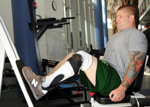
Spc. Michael Krapels, uses an IDEO during physical therapy at the Center for the Intrepid. Photograph courtesy of Steven Galvan, U. S. Army Medicine.
Two studies published in the November issue of Military Medicine focus on data related to the Intrepid Dynamic Exoskeleton Orthosis (IDEO).
Descriptive Characteristics and Amputation Rates With Use of Intrepid Dynamic Exoskeleton Orthosis:
The authors of this study wrote that advancements in AFOs, such as the IDEO, are designed to improve function and reduce pain of an injured lower limb. Noting a lack of research, however, the stated purpose of the study was to describe the demographics, presenting diagnosis, and patterns of amputation in patients prescribed an IDEO at the Brooke Army Medical Center’s Center for the Intrepid (CFI), San Antonio, Texas. The studied population was 624 service members who were and prescribed an IDEO between 2009 and 2014. Data was extracted from the Expeditionary Medical Encounter Database, Defense Manpower Data Center, Military Health System Data Repository, and CFI patient records for demographic and injury information as well as an amputation outcome.
The most common injury category that received an IDEO prescription was injury at or surrounding the ankle joint (25 percent), followed by tibia injury (17.5 percent), and nerve injury below the knee (16.4 percent). Over 80 percent of the sample avoided amputation within a one-year period while using the IDEO. The researchers suggest that future studies should track IDEO users longitudinally for a longer period to determine the long-term viability of the device.
The authors of this study sought to rate available evidence and formulate empirical evidence statements (EESs) regarding outcomes associated with IDEO use. PubMed, CINAHL, and Google Scholar were systematically searched for pertinent articles, which were screened and rated. EESs were formulated based upon data and conclusions from the included studies. Twelve studies were identified and rated, and 487 subjects were studied following limb trauma and salvage. Subjects had a mean age of 29.4 years and included six women. All included studies had high external validity, whereas internal validity was mixed because of reporting issues, according to the researchers.
Moderate evidence supported development of four EESs regarding IDEO use with the specialized Return to Run therapy program. Following high-energy lower-limb trauma and limb salvage, use of IDEO with specialized therapy can enable return to duty and return to recreation and physical activity, and decrease pain in some high-functioning patients. In higher functioning patients, IDEO use improved agility, power, and speed, when compared with no-brace or conventional bracing alternatives.




